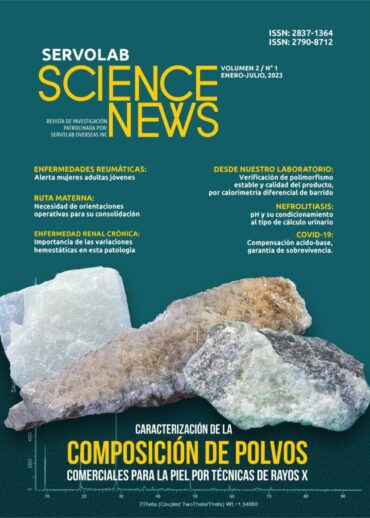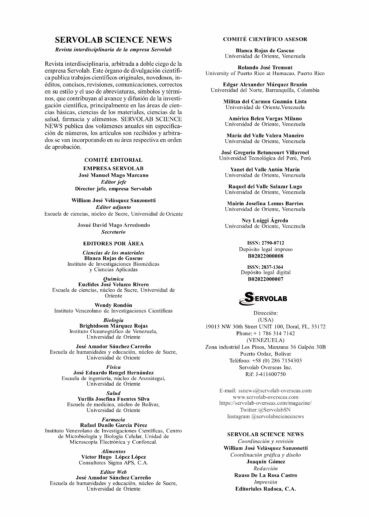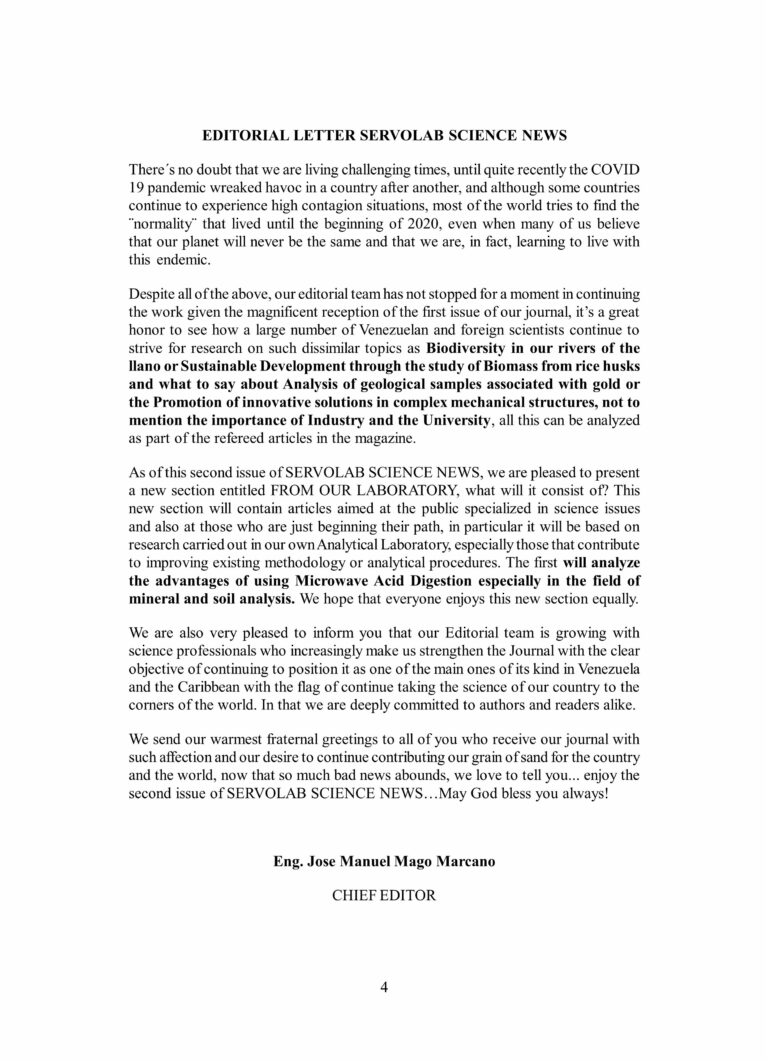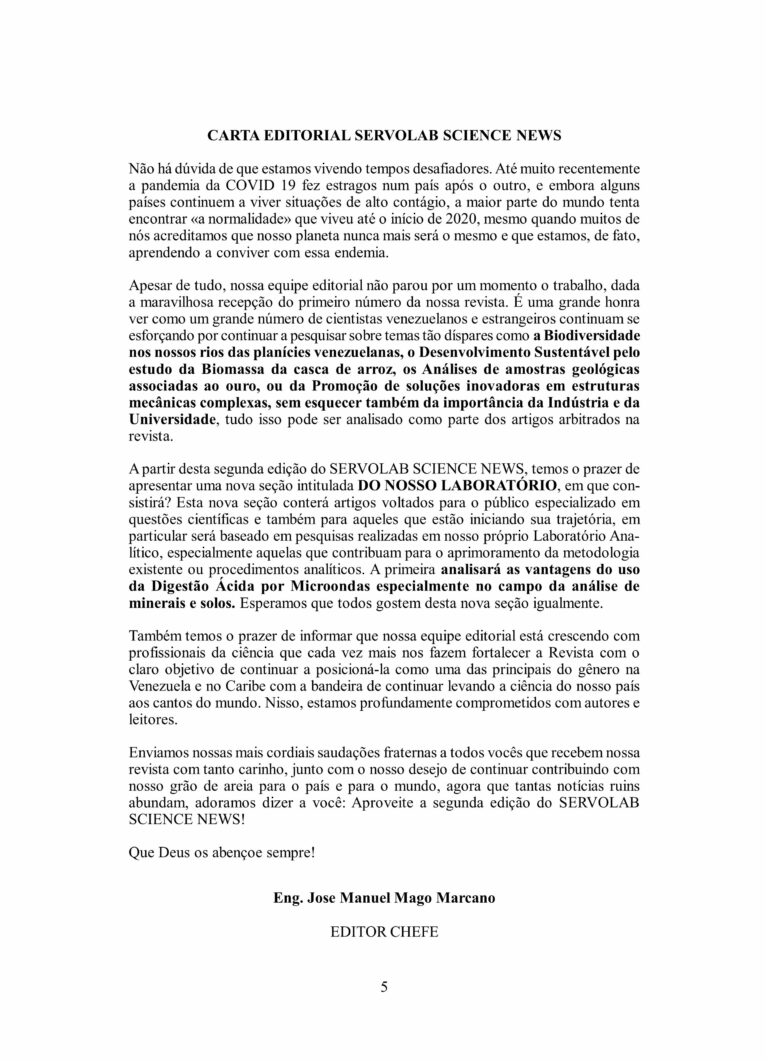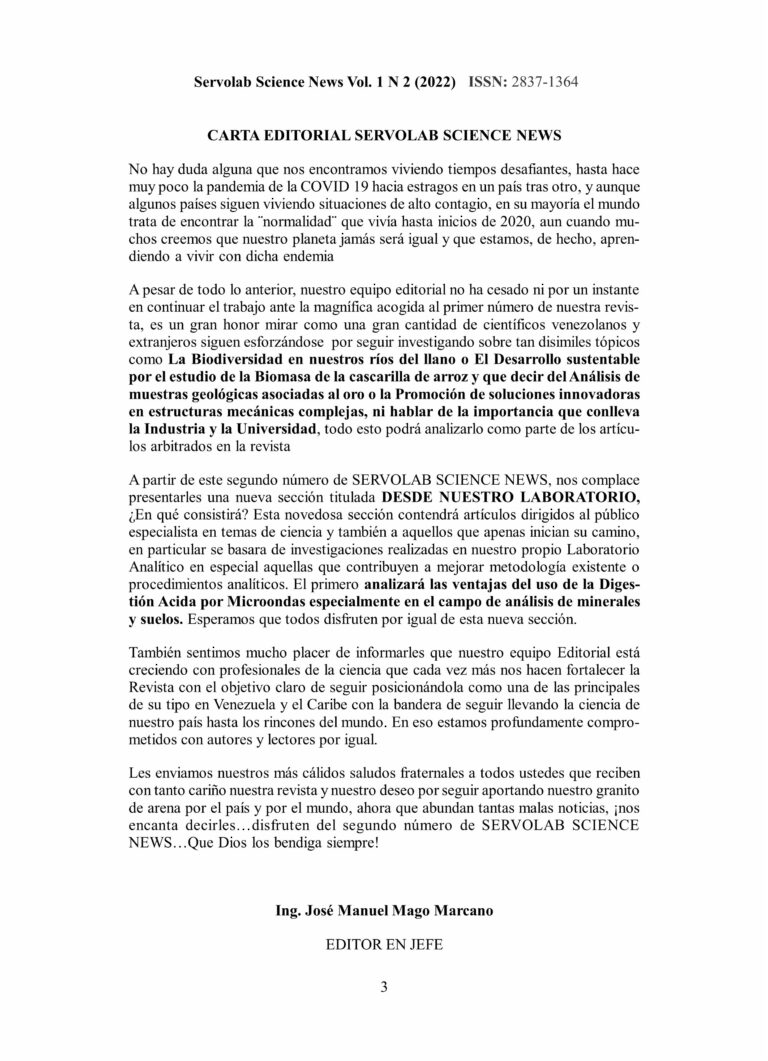Vol. 2 N° 1 (2023) Janeiro-Junho
- Inicio
- Revistas científicas
- Vol. 2 N° 1 (2023) Janeiro-Junho
Vol. 2 N° 1 (2023) Janeiro-Junho
Leia mais sobre o
Publicado: (2023)
USE OF DIFFERENTIAL SCANNING CALORIMETRY FOR THE IDENTIFICATION OF POLYMORPHISM IN COMMERCIAL CHOCOLATES
DANIEL GONZÁLEZ², RICHARD HENRÍQUEZ², EUCLIDES JOSÉ VELAZCO¹, JOSUÉ DAVID MAGO ARREDONDO¹, JOSÉ MANUEL MAGO MARCANO¹
The study of polymorphism in solid fats, such as cocoa butter and the main component of chocolate, can be done using different instrumental analytical techniques. In the chocolate industry, the search for the desired product is influenced by the presence of a certain polymorph of cocoa butter, which can be obtained depending on the temperatures at which the chocolate is treated during its production. The objective of this technical report is to use the analytical technique of differential scanning calorimetry for the determination of polymorphism in chocolates. Three different types of commercial chocolates (milk, white and dark chocolate) were used for the analyses. The sample size was approximately 10 mg. The analyzes were carried out in a differential scanning calorimeter NETZCH, model DSC 214 Polyma (Fig. 1a) following a controlled heating-cooling-heating program. The results obtained allowed us to verify, according to the melting temperatures detected, the presence of the most stable polymorph (polymorph V) in milk chocolate and dark chocolate; while white chocolate showed the presence of polymorph VI, also stable. This method shows the advantage of reducing the time lapse in obtaining temperature profiles through heating and cooling rates of up to 500 K/min, thus carrying out the comparison of polymorphisms of the different chocolate samples for the determination of its quality.
Key words: polymorphism, chocolate, DSC, thermal analysis
CHARACTERIZATION OF THE COMPOSITION OF COMMERCIAL SKIN POWDER BY X RAY TECHNIQUES
EUCLIDES JOSÉ VELAZCO RIVERO¹,², RICHARD RAFAEL HENRÍQUEZ TORRES¹, DANIEL ALEJANDRO GONZÁLEZ¹, JOSUÉ DAVID MAGO ARREDONDO¹
Commercial skin powders are cosmetic products that are generally made from mineral talc, a silicate with the formula 3MgO·4SiO₂·H₂O. International regulations establish special compositions for these products to consider them for commercial use, outside of these ranges the powder is considered for industrial use. The objective of this work was to evaluate the composition of some commercial talcums available in regular stores by X-ray techniques. Five commercial brands were selected that included baby powders and foot powders, four of them based on talc and one based on corn starch, whose origins are China, India and Venezuela. The mineral phases present in these products were identified and quantified by X-ray diffraction (DRX); while the elemental chemical composition was evaluated by X-ray fluorescence (XRF). The results obtained reveal that, of the five commercial brands evaluated, three of them do not meet the conditions to be considered commercial powders for human use, showing compositions that differ from what is indicated on the product labels. Of these three trademarks, one of them does not contain talc, despite being indicated on the product and its composition is based on carbonaceous compounds (calcite, aragonite and dolomite); while the other two contain dolomite as a major component. Only the product from Venezuela (talc-based) and the one originating from India (corn starch-based) meet the specifications indicated by the manufacturers. Products that do not comply with the indicated formulations can be considered as industrial grade products due to their composition.
Key words: Talc, X-rays, diffraction, fluorescence
ACID-BASE VARIATIONS ABOUT THE TYPE OF URINARY CONCRETION, IN PATIENTS WITH UROLITHIASICS IN THE CITY OF CUMANA, SUCRE STATE
WILLIAM JOSÉ VELÁSQUEZ SANZONETTI¹, AMÉRICA BELÉN VARGAS MILANO², DIXSON JOSÉ VELÁSQUEZ SANZONETTI³, SOLANMY MARÍA PATIÑO VELÁSQUEZ⁴, JEROSCA AURELIS LLOVERA VELÁSQUEZ¹
Urolithiasis is a pathology characterized by the precipitation of lithogenic crystals in the renal system, in relation to the urinary PH, causing the formation of concretions that can lead to obstructive symptoms in the urinary tract. The objective of this study was to evaluate the variations of the acid-base balance, in relation to the type of urinary concretions, measured in urolithiasic patients, coming from the Urology service of the “Antonio Patricio de Alcalá” university hospital in the city of Cumaná, Sucre state and in a group of apparently healthy individuals. To achieve this end, 50 male and female control individuals, aged between 17 and 56 years, and 50 males and female urolithiasis patients, aged between 14 and 69 years, were studied. Samples of 6.00 mL of venous blood were collected from both groups of individuals, 3.00 mL for the determination of the haematological parameter hemoglobin and 3.00 mL for the quantification of the acid-base parameters pH, oxygen pressure (pO₂), pressure of carbon dioxide (pCO₂), bicarbonate (CO₃H) and total carbon dioxide (CO₂T). The identification of the crystals present in the urinary calculi was carried out using the X-ray diffraction technique. The results obtained in the present study showed significant differences in the parameters pH, pO₂, pCO₂, CO₃H and CO₂T, when evaluated with the test t-Student statistic in urolithiasis individuals and controls. All of the above allows us to point out that the urolithiasis patients analyzed in this study, when compared with control individuals, probably present with significant alterations in the acid-base balance caused by multiple factors such as metabolic alterations, obstructive conditions of the renal tract, inflammatory processes, recurrent urinary infections and dehydration due to high temperatures registered in the Sucre state.
Key words: Nephrolithiasis, hydrogen ions, bicarbonatemia, urinary concretions
ASSOCIATION BETWEEN RHEUMATIC DISEASES AND THE EPIDEMIOLOGICAL PARAMETERS OF AGE AND SEX IN PATIENTS AT THE PHYSIATRIC OFFICE OF THE ROTARY HEALTH CENTER DR. TOMÁS TOLEDO PADILLA, CUMANÁ- SUCRE STATE
HERYMAR WALKIRA REYES BASTARDO¹, VALERIA DE LOS ÁNGELES GUEVARA RODRÍGUEZ¹, OSMARILYS JOSÉ SULBARÁN CASTILLO¹, YANET DEL VALLE ANTÓN MARÍN²
Rheumatic diseases significantly affect the musculoskeletal system and are more common in women and in any age group. The objective of the present investigation was to evaluate the association between rheumatic diseases and age and sex parameters in patients of the physiatry clinic of the rotary health center, Dr. Tomás Toledo Padilla, Cumaná- Sucre State. To achieve this purpose, an observational, descriptive, field and cross-sectional study was carried out in a total of 25 patients diagnosed with rheumatic tendinitis, scoliosis, arthritis, osteoarthritis, capsulitis and bursitis. who attended the aforementioned consultation. The age and sex parameters were represented based on absolute and percentage frequencies, to associate them with the aforementioned rheumatic diseases. The data obtained were subjected to the chi-square (χ²), statistical analysis, yielding a highly significant association that was signified by rheumatic diseases and the age referenced by the age group of 21-40 years, as well as rheumatic diseases and the female sex, with attention to scoliosis and tendinitis in both parameters. These results allow us to deduce that scoliosis is associated with the female sex and the age group between 21-40 years.
Keywords: Scoliosis, tendinitis, osteoarthritis.
MATERNAL ROUTE AS A HUMAN RIGHTS GUARANTEE STRATEGY IN THE SUCRE STATE, YEAR 2022
MÓNICA ANDREINA VELASCO DE GAMBOA¹, DAMARIS ZERPA DE MÁRQUEZ¹,²
In Venezuela, there are policies to promote prevention rather than cure, territorialization of health services and the creation and strengthening of a National Public Health System that guarantees ensuring the human right to health and therefore to life, which prompted the creation of care units, strategies and programs for quality care for pregnant women. Given the increase in the number of complications in pregnancy and maternal and infant deaths, the Sexual and Reproductive Health Program and the maternal route strategy were created, which is a strategy for monitoring pregnant women, regarding prenatal care, follow-up, accompaniment and control, for the reduction of severe maternal morbidity, maternal and neonatal mortality. In the state of Sucre, the Maternal Route was incorporated as a strategy, so the research objective was to analyze the maternal route as a strategy to guarantee human rights in the state of Sucre, year 2022, through a qualitative study using the dialectical hermeneutic method. Information was obtained through an in-depth interview. The results raise the need for operational guidelines for the consolidation of the maternal route in the state of Sucre, where there is currently a presence of international organizations linked to health, especially dedicated to children and adolescents and maternal and child health. It concludes on the need for operational guidelines for the consolidation of the maternal route in the state of Sucre, around: right to maternity, safe and happy motherhood, institutionalization and maternity, family planning, territorialization of the strategy, planning and articulation, obstetric fear and guarantee of material conditions, which are supported in two transversal axes: awareness and empathy and organic functioning of the strategy.
Keywords: Maternity, maternal route, strategy, human rights.
ACID-BASE BALANCE DISORDERS IN PATIENTS WITH COVID-19, ON ADMISSION AND DISCHARGE, FROM THE CRITICAL RESPIRATORY UNIT OF THE ANTONIO PATRICIO DE ALCALA UNIVERSITY HOSPITAL, CUMANA, SUCRE STATE
FELICIA ANTONIA MONTAÑO CARMONA¹; WILLIAM JOSÉ VELÁSQUEZ SANZONETTI²
COVID-19 is a pathology that presents a high prevalence of pneumonia and kidney injury that leads to acid-base disorders in patients admitted with SARS-Cov-2 infection.
The aforementioned constitutes the theoretical basis for carrying out the present study that aims to evaluate the variations in acid-base parameters in patients with COVID-19, from the critical respiratory unit, of the Antonio Patricio de Alcalá university hospital in the city of Cumana, Sucre state. To achieve this purpose, arterial blood samples were taken from 30 patients diagnosed with COVID-19 pathology, from whom the acid-base parameters pH, carbon dioxide pressure (pCO2), oxygen pressure (pO2) were determined., bicarbonate concentration [HCO3] and oxygen saturation (SatO2). The results of the application of the t-Student statistical test showed highly significant differences in the parameters pH, pCO2, pO2, [HCO3] and SatO2 with decreased input values in the parameters pH, pO2, and SatO2 and increased pCO2 and [ HCO3] and increased output values in the parameters pH, pO2 and SatO2 and decreased pCO2 and [HCO3]. All of this allows us to conclude that the patients with COVID-19, analyzed in this study, were admitted with an acid-base condition of compensated respiratory acidemia and were discharged with compensated acid-base parameters, a fact that can be evidenced by observing the average pH value of 7.40.
Keywords: Covid-19, blood gases, pH, acid-base alterations.
HEMOSTATIC VARIATIONS IN HEMODIALIZED PATIENTS WITH CHRONIC KIDNEY DISEASE AT THE DIALYSIS UNIT OF THE ANTONIO PATRICIO DE ALCALÁ UNIVERSITY HOSPITAL CUMANÁ, SUCRE STATE
AMÉRICA BELÉN VARGAS MILANO¹, WILLIAM JOSÉ VELÁSQUEZ SANZONETTI², CATHERINE DEL VALLE CABALLERO GUERRA¹
Chronic kidney disease (CKD) is characterized by the irreversible loss of kidney function, becoming a public health problem that leads to low quality of life and premature death in patients who suffer from it. The objective of this study was to evaluate the hemostatic variations in control individuals and patients with chronic kidney disease (CKD) from the dialysis unit of the Antonio Patricio de Alcalá university hospital in the city of Cumaná, Sucre state to achieve this end. 40 apparently healthy and 18 CKD patients with hemodialysis treatment with ages between 10 and 70 years of age, of both sexes (male and female) were studied blood samples from the two aforementioned groups of individuals were analyzed, in which the plasmatic parameters prothrombin time (PT), activated partial thromboplastin time (PTT), fibrinogen and the serum parameter calcium were determined. The t-Student statistical analysis showed significant differences in the hemostatic parameters TP, TTP, and fibrinogen with increased mean values in CKD patients and non-significant differences in calcium ion concentration. These results allow us to point out that CKD and liver imbalances may be the cause of the lengthening of coagulation times and the increases in fibrinogen and calcium ion experienced by the nephropathic individuals who participated in this study.
Key words: Nephropathies, hemostasis, coagulation times.

